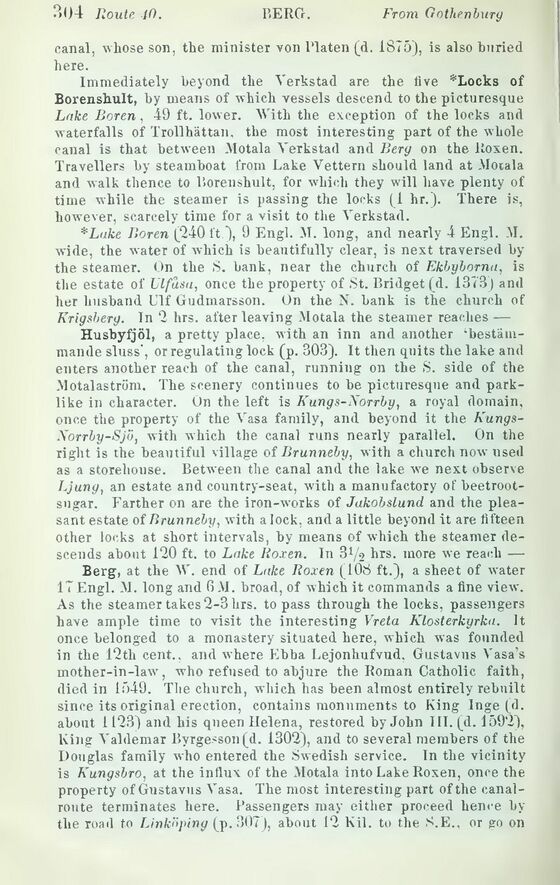
Full resolution (JPEG) - On this page / på denna sida - Sweden - Pages ...

<< prev. page << föreg. sida << >> nästa sida >> next page >>
Below is the raw OCR text
from the above scanned image.
Do you see an error? Proofread the page now!
Här nedan syns maskintolkade texten från faksimilbilden ovan.
Ser du något fel? Korrekturläs sidan nu!
This page has never been proofread. / Denna sida har aldrig korrekturlästs.
canal, whose son, the minister von Platen (d. 1875), is also buried
here.
Immediately beyond the Verkstad are the five *Locks of
Borenshult, by means of which vessels descend to the picturesque
Lake Boren, 49 ft. lower. With the exception of the locks and
waterfalls of Trollhättan, the most interesting part of the whole
canal is that between Motala Verkstad and Berg on the Roxen.
Travellers by steamboat from Lake Vettern should land at Moiala
and walk thence to Borenshult, for which they will have plenty of
time while the steamer is passing the locks (1 hr.). There is,
however, scarcely time for a visit to the Verkstad.
*Luke Boren (240 ft ), 9 Engl. M. long, and nearly 4 Engl. M.
wide, the water of which is beautifully clear, is next traversed by
the steamer. On the S. bank, near the church of Ekbybornu, is
the estate of Ulfusa, once the property of St. Bridget (d. 1373) and
her husband Ulf Gudmarsson. On the N. bank is the church of
Krigsberg. In 2 hrs. after leaving Motala the steamer reaches —
Husbyfjöl, a pretty place, with an inn and another
‘bestämmande sluss’, or regulating lock (p. 303). It then quits the lake and
enters another reach of the canal, running on the S. side of the
Motalaström. The scenery continues to be picturesque and
parklike in character. On the left is Kungs-Xorrby, a royal domain,
once the property of the Vasa family, and beyond it the
Kungs-Xorrby-Sjb, with which the canal runs nearly parallel. On the
right is the beautiful village of Brunneby, with a church now used
as a storehouse. Between the canal and the lake we next observe
Ljung, an estate and country-seat, with a manufactory of
beetroot-sugar. Farther on are the iron-works of Jakobslund. and the
pleasant estate of Brunneby, with a lock, and a little beyond it are fifteen
other locks at short intervals, by means of which the steamer
descends about 120 ft. to Lake Roxen. In 37s hrs. more we reach —
Berg, at the V. end of Lake Roxen (108 ft.), a sheet of water
17 Engl. M. long and fiM. broad, of which it commands a fine view.
As the steamer takes 2-3 hrs. to pass through the locks, passengers
have ample time to visit the interesting Vreta Klosterkyrka. It
once belonged to a monastery situated here, which was founded
in the 12th cent., and where Ebba Lejonhufvud, Gustavns Vasa’s
mother-in-law, who refused to abjure the Roman Catholic faith,
died in 1049. The church, which has been almost entirely rebuilt
since its original erection, contains monuments to King Inge (d.
about 1123) and his queen Helena, restored by John III. (d. 1592),
King Valdemar Byrgesson(d. 1302), and to several members of the
Douglas family who entered the Swedish service. In the vicinity
is Kungsbro, at the influx of the Motala into Lake Roxen, once the
property of Gustavns Vasa. The most interesting part of the
canal-route terminates here. Passengers may either proceed hence by
the road to Linköping (p. 307), about 12 Kil. to the S.E., or go on
<< prev. page << föreg. sida << >> nästa sida >> next page >>